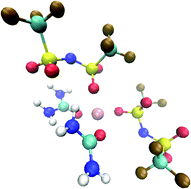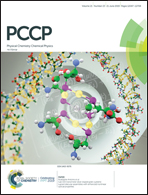Mixtures of LiTFSI and urea: ideal thermodynamic behavior as key to the formation of deep eutectic solvents?†
Abstract
At certain mixing ratios, urea and lithium bis(trifluorosulfonyl)imide (LiTFSI) form deep eutectic solvents with a pronounced lowering of the melting temperature when compared to the individual components. Using atomistic molecular dynamics (MD) simulations and density functional theory (DFT) calculations, we study the structural and dynamic properties of these mixtures at various urea concentrations. Our findings show that the diffusivity of all species increases linearly with the urea mole fraction which can be explained by a successive replacement of TFSI− ions from the first coordination shell around lithium ions. A comparable linear change is also observed for the interaction energies between the individual components. Broad electrochemical stability windows in combination with high lithium ion transport numbers are brought into agreement with electronic reshuffling mechanisms between the interacting species. Further calculations of chemical potential derivatives and transfer free energies highlight an ideal thermodynamic behavior for certain LiTFSI/urea mixing ratios. Our findings thus provide a rationale for the unique properties of these mixtures in reasonable agreement with experimental outcomes.



 Please wait while we load your content...
Please wait while we load your content...